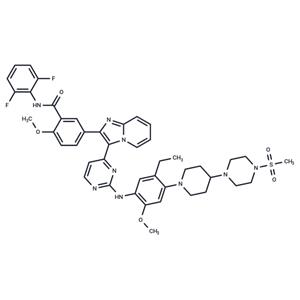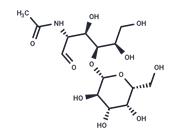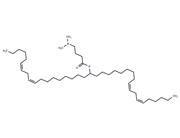| Name | GSK1904529A |
| Description | GSK1904529A (GSK 4529) is a specific inhibitor of IGF-1R (IC50=27 nM) and IR(IC50=25 nM) . |
| Cell Research | Cells are seeded in 96-well plates and incubated overnight at 37 °C, and treated with various concentrations of GSK1904529A for 72 hours. For the NIH-3T3/LISN, cells are seeded on collagen-coated 96-well tissue culture plates and allowed to adhere for 24 hours. The tissue culture medium is replaced with serum-free medium and the cells are treated with DMSO or GSK1904529A for 2 hours. IGF-I (30 ng/mL) is added and the cells are incubated at 37 °C for 72 hours. Cell proliferation is quantified using the CellTiter-Glo Luminescent Cell Viability Assay. IC50 values are determined. |
| Kinase Assay | Kinase assays: GSK1904529A is dissolved in DMSO as stock solution at 10 mM. Baculovirus-expressed glutathione S-transferase-tagged proteins encoding the intracellular domain of IGF-1R (amino acids 957-1367) and IR (amino acids 979-1382) are used for determination of IC50. Kinases are activated by preincubating the enzyme (2.7 μM final concentration) in 50 mM HEPES (pH 7.5), 10 mM MgCl2, 0.1 mg/mL bovine serum albumin, and 2 mM ATP. GSK1904529A is diluted in DMSO and dispensed into the assay plates (100 nL/well). Kinase reactions contained (in 10 μL) 50 mM HEPES (pH 7.5), 3 mM DTT, 0.1 mg/mL bovine serum albumin, 1 mM CHAPS, 10 mM MgCl2, 10 μM ATP, 500 nM substrate peptide (biotin-aminohexylAEEEEYMMMMAKKKK-NH2; QPC), and 0.5 nM activated enzyme. Reactions are stopped after 1 hour at room temperature with 33 μM EDTA. Peptide phosphorylation is measured by time-resolved fluorescence resonance energy transfer with 7 nM streptavidin Surelight allophycocyanin and 1 nM europium-conjugated phosphotyrosine antibodies. Plates are read in a multilabel reader. |
| In vitro | GSK1904529A is a reversible, ATP-competitive inhibitor and has enzyme-inhibitor binding values against IGF-1R and IR with Ki of 1.6 nM and 1.3 nM, respectively. GSK1904529A potently inhibits the ligand-induced phosphorylation of IGF-1R and IR at concentrations above 0.01 μM, followed by blocking downstream signaling (AKT, IRS-1, and ERK). GSK1904529A potently inhibits NIH-3T3/LISN, TC-71, SK-N-MC, SK-ES RD-ES cells with IC50 of 60 nM, 35 nM, 43 nM, 61 nM and 62 nM, respectively. GSK1904529A also inhibits other multiple myeloma and Ewing's sarcoma cell lines including NCI-H929, MOLP-8, LP-1 and KMS-12-BM etc. GSK1904529A induces cell cycle arrest at the G1 phase in cell lines COLO 205, MCF-7, and NCI-H929, which are sensitive to GK1904529A. [1] |
| In vivo | GSK1904529A indicates 98% tumor growth inhibition in NIH-3T3/LISN tumor-bearing mice at a dose of 30 mg/kg (orally, twice-daily) and 75% in COLO 205 xenografts mice (once daily). Among HT29 and BxPC3 xenografts, GSK1904529A produces moderate tumor growth inhibition with no side effects at a dose of 30 mg/kg. Meanwhile, GSK1904529A shows minimal effects on blood glucose levels. GSK1904529A (~3.5 μM in blood) completely inhibits IGF-1R phosphorylation. GSK1904529A has been implicated in treatment of various IGF-1R-dependent tumors including prostate, colon, breast, pancreatic, ovarian, and sarcomas. [1] |
| Storage | Powder: -20°C for 3 years | In solvent: -80°C for 1 year | Shipping with blue ice. |
| Solubility Information | H2O : < 1 mg/mL (insoluble or slightly soluble)
Ethanol : < 1 mg/mL (insoluble or slightly soluble)
DMSO : 114 mg/mL (133.8 mM)
|
| Keywords | Insulin Receptor | Apoptosis | Inhibitor | anti-tumor | GSK1904529A | GSK4529 | GSK-1904529A | IGF-1R | inhibit | insulin | GSK-4529 |
| Inhibitors Related | Stavudine | 5-Fluorouracil | Acetylcysteine | Kaempferol | Myricetin | Sodium 4-phenylbutyrate | L-Ascorbic acid | Dextran sulfate sodium salt (MW 4500-5500) | Metronidazole | Sorafenib | Tributyrin | Lidocaine hydrochloride |
| Related Compound Libraries | Bioactive Compound Library | Pain-Related Compound Library | Membrane Protein-targeted Compound Library | Tyrosine Kinase Inhibitor Library | Kinase Inhibitor Library | Inhibitor Library | Anti-Aging Compound Library | Bioactive Compounds Library Max | Fluorochemical Library | Anti-Cancer Active Compound Library |

 United States
United States



